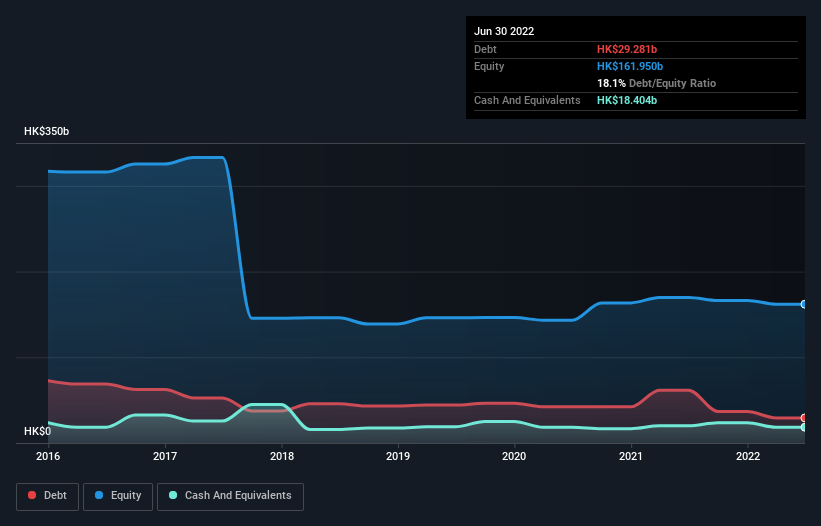
Some say volatility, rather than debt, is the best way to think about risk as an investor, but Warren Buffett famously said that 'Volatility is far from synonymous with risk.' When we think about how risky a company is, we always like to look at its use of debt, since debt overload can lead to ruin. Importantly, Wharf (Holdings) Limited (HKG:4) does carry debt. But the more important question is: how much risk is that debt creating?
Why Does Debt Bring Risk?
Debt and other liabilities become risky for a business when it cannot easily fulfill those obligations, either with free cash flow or by raising capital at an attractive price. If things get really bad, the lenders can take control of the business. However, a more frequent (but still costly) occurrence is where a company must issue shares at bargain-basement prices, permanently diluting shareholders, just to shore up its balance sheet. Of course, debt can be an important tool in businesses, particularly capital heavy businesses. The first step when considering a company's debt levels is to consider its cash and debt together.
See our latest analysis for Wharf (Holdings)
How Much Debt Does Wharf (Holdings) Carry?
You can click the graphic below for the historical numbers, but it shows that Wharf (Holdings) had HK$29.3b of debt in June 2022, down from HK$61.6b, one year before. However, because it has a cash reserve of HK$18.4b, its net debt is less, at about HK$10.9b.

How Strong Is Wharf (Holdings)'s Balance Sheet?
Zooming in on the latest balance sheet data, we can see that Wharf (Holdings) had liabilities of HK$38.8b due within 12 months and liabilities of HK$41.9b due beyond that. Offsetting these obligations, it had cash of HK$18.4b as well as receivables valued at HK$2.44b due within 12 months. So it has liabilities totalling HK$59.8b more than its cash and near-term receivables, combined.
This is a mountain of leverage relative to its market capitalization of HK$72.7b. Should its lenders demand that it shore up the balance sheet, shareholders would likely face severe dilution.
We use two main ratios to inform us about debt levels relative to earnings. The first is net debt divided by earnings before interest, tax, depreciation, and amortization (EBITDA), while the second is how many times its earnings before interest and tax (EBIT) covers its interest expense (or its interest cover, for short). This way, we consider both the absolute quantum of the debt, as well as the interest rates paid on it.
Wharf (Holdings) has a low net debt to EBITDA ratio of only 1.3. And its EBIT easily covers its interest expense, being 58.0 times the size. So you could argue it is no more threatened by its debt than an elephant is by a mouse. In fact Wharf (Holdings)'s saving grace is its low debt levels, because its EBIT has tanked 40% in the last twelve months. When a company sees its earnings tank, it can sometimes find its relationships with its lenders turn sour. The balance sheet is clearly the area to focus on when you are analysing debt. But ultimately the future profitability of the business will decide if Wharf (Holdings) can strengthen its balance sheet over time. So if you're focused on the future you can check out this free report showing analyst profit forecasts.
But our final consideration is also important, because a company cannot pay debt with paper profits; it needs cold hard cash. So it's worth checking how much of that EBIT is backed by free cash flow. Over the last three years, Wharf (Holdings) recorded free cash flow worth a fulsome 83% of its EBIT, which is stronger than we'd usually expect. That positions it well to pay down debt if desirable to do so.
Our View
We feel some trepidation about Wharf (Holdings)'s difficulty EBIT growth rate, but we've got positives to focus on, too. To wit both its interest cover and conversion of EBIT to free cash flow were encouraging signs. Looking at all the angles mentioned above, it does seem to us that Wharf (Holdings) is a somewhat risky investment as a result of its debt. That's not necessarily a bad thing, since leverage can boost returns on equity, but it is something to be aware of. In light of our reservations about the company's balance sheet, it seems sensible to check if insiders have been selling shares recently.
At the end of the day, it's often better to focus on companies that are free from net debt. You can access our special list of such companies (all with a track record of profit growth). It's free.
Valuation is complex, but we're here to simplify it.
Discover if Wharf (Holdings) might be undervalued or overvalued with our detailed analysis, featuring fair value estimates, potential risks, dividends, insider trades, and its financial condition.
Access Free AnalysisHave feedback on this article? Concerned about the content? Get in touch with us directly. Alternatively, email editorial-team (at) simplywallst.com.
This article by Simply Wall St is general in nature. We provide commentary based on historical data and analyst forecasts only using an unbiased methodology and our articles are not intended to be financial advice. It does not constitute a recommendation to buy or sell any stock, and does not take account of your objectives, or your financial situation. We aim to bring you long-term focused analysis driven by fundamental data. Note that our analysis may not factor in the latest price-sensitive company announcements or qualitative material. Simply Wall St has no position in any stocks mentioned.
About SEHK:4
Wharf (Holdings)
Founded in 1886 as the 17th company registered in Hong Kong, The Wharf (Holdings) Limited (Stock Code: 0004) is a premier company with strong connection to the history of Hong Kong.
Excellent balance sheet with moderate growth potential.


